Key takeaways
- Activist teacher resources empower educators to foster critical thinking and social justice awareness in classrooms, moving students from passive learners to active participants.
- Kahoot enhances classroom engagement by transforming learning into interactive, game-like experiences and accommodating diverse learning styles with real-time feedback.
- Incorporating Kahoot for warming up lessons and promoting thoughtful discussions encourages critical thinking and allows for richer classroom conversations.
- Challenges such as technical glitches or overly competitive environments can be mitigated by having backup plans and emphasizing respect and collaboration during activities.

Understanding activist teacher resources
Activist teacher resources are more than just lesson plans or handouts; they are tools that empower educators to challenge the status quo and inspire critical thinking. From my experience, these resources are often rooted in social justice, aiming to create classrooms where every student’s voice matters. Have you ever felt that a traditional curriculum falls short in addressing real-world issues? That’s where activist resources make a difference.
What strikes me most about these materials is their focus on fostering empathy and awareness. They encourage us, as teachers, to connect learning to larger societal movements and injustices, which can be both challenging and deeply rewarding. Using these resources, I’ve seen students move from passive learners to active participants eager to question and engage critically with the world around them.
I also wonder how many teachers feel equipped to navigate the complexities these resources bring. It’s not always easy to balance activism with the demands of standardized testing, yet these tools remind me that teaching is about more than test scores—it’s about nurturing informed, compassionate citizens. Don’t you think that’s a goal worth striving for?
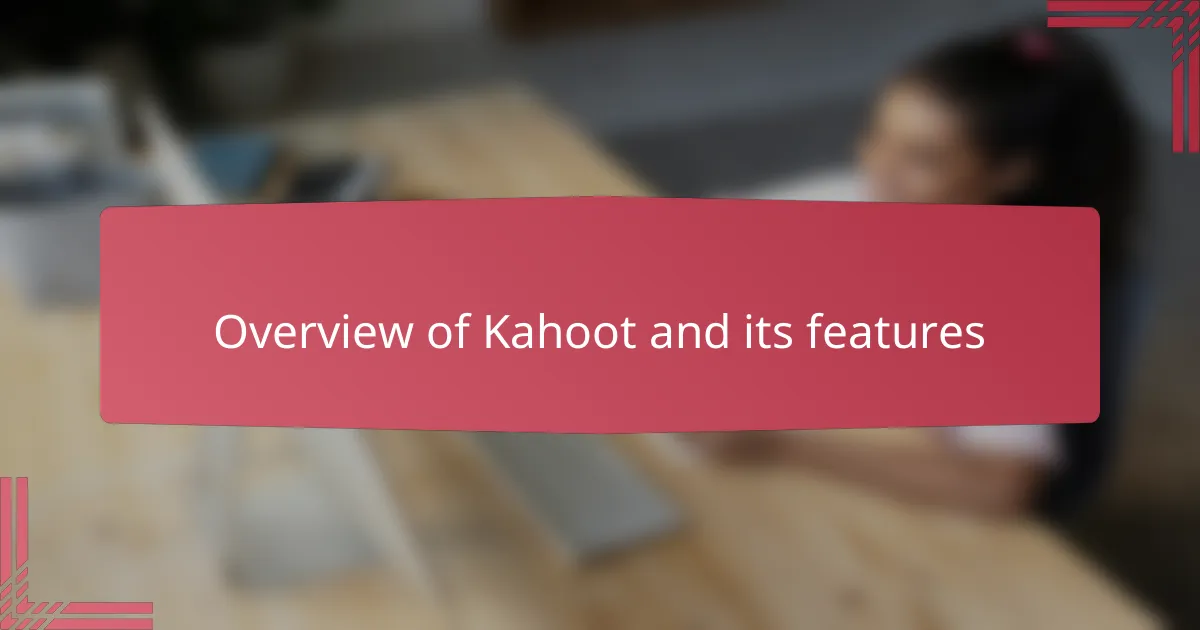
Overview of Kahoot and its features
Kahoot is an online platform that turns lessons into interactive quizzes, polls, and discussions. What I find fascinating is how it transforms a typical classroom moment into a lively, game-like experience that instantly grabs students’ attention. Have you ever noticed how a bit of friendly competition can spark unexpected enthusiasm in a lesson?
One of Kahoot’s standout features is its real-time feedback, which lets both teachers and students see how well everyone is understanding the material. From my experience, this immediate insight helps me adjust my teaching on the fly and keeps students more engaged, especially when tackling complex topics. It’s like having a pulse on the classroom’s learning rhythm at every moment.
I also appreciate how Kahoot accommodates various learning styles through its mix of multiple-choice questions, open-ended prompts, and even surveys. This variety makes it easier to include diverse perspectives, which is crucial when addressing activist themes in the classroom. Have you tried mixing different question types to pull out richer discussions? For me, it’s been a game-changer in creating spaces where all voices can be heard.
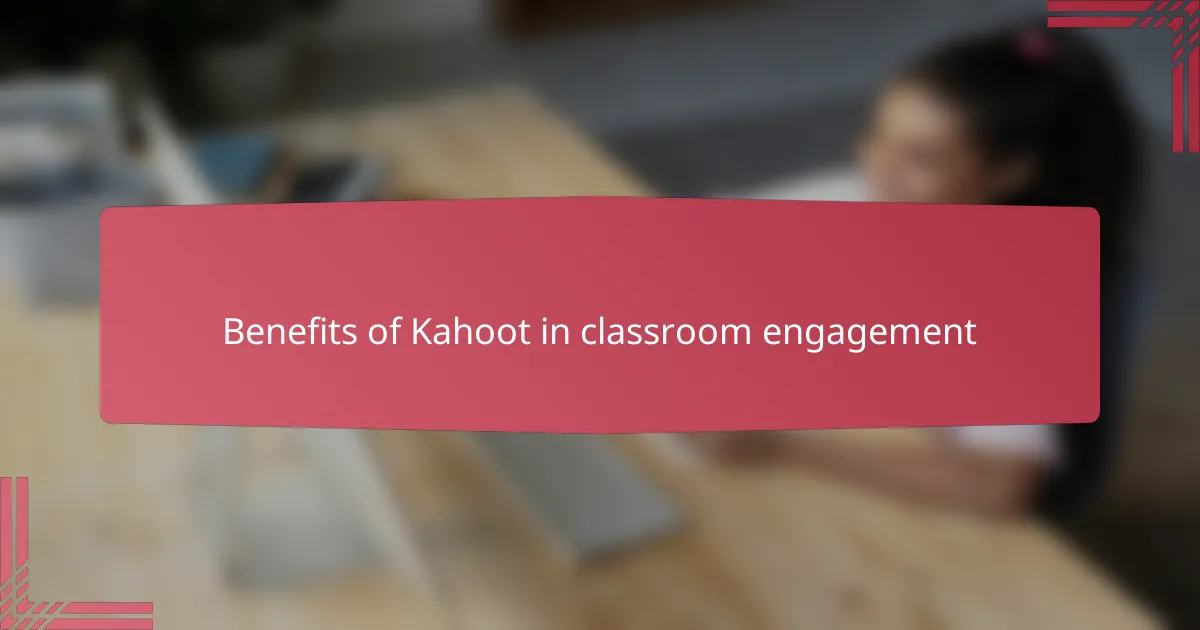
Benefits of Kahoot in classroom engagement
When I first integrated Kahoot into my lessons, I was struck by how instantly it grabbed students’ attention. The competitive element turns engagement into a fun challenge rather than a chore. Isn’t it amazing how a simple game can shift the energy in the room so dramatically?
What really stands out to me is how Kahoot encourages participation from even the quieter students. In my experience, those who usually hesitate to speak up suddenly want to join in when they see their answers reflected in real time. Have you noticed that giving students a low-pressure way to contribute can open up their voices?
Beyond just boosting involvement, Kahoot also sparks critical thinking by prompting immediate reflection on questions. I’ve seen students debate answers and dive deeper into issues because the platform creates a dynamic space where learning feels active. Doesn’t it feel empowering when students aren’t just absorbing information but actually wrestling with it?
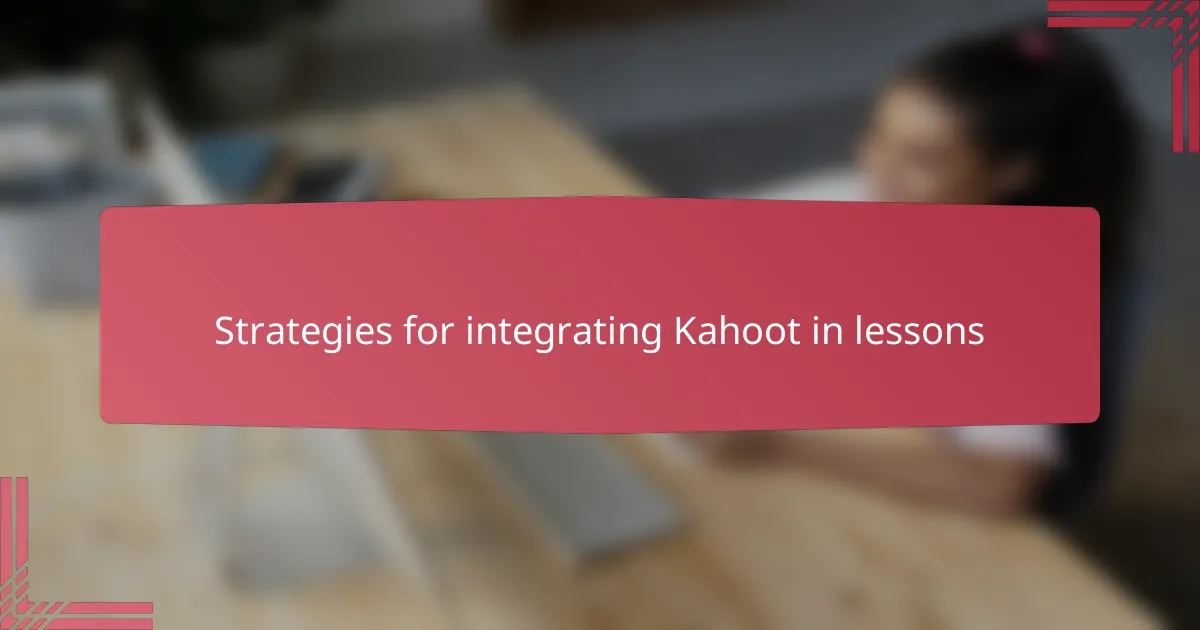
Strategies for integrating Kahoot in lessons
One strategy I’ve found effective is to use Kahoot as a warm-up or exit ticket activity. Starting a lesson with a quick quiz can ignite curiosity and set the tone for deeper discussions later. Have you ever seen how a few rapid-fire questions can instantly energize a room and prime students for exploring tough topics?
Another approach that works well, especially with activist content, is to design Kahoot quizzes that include thought-provoking questions rather than just factual ones. From my experience, mixing in open-ended prompts or opinion polls encourages students to reflect critically right from their devices. It’s like turning the platform into a virtual dialogue space where everyone’s perspective matters.
I also like to integrate Kahoot mid-lesson as a checkpoint to gauge understanding and adjust my teaching accordingly. When I see students’ answers in real time, it’s easier to spot misconceptions before they take root. Have you noticed how this immediate feedback can transform a static lecture into a responsive conversation? It makes every voice count in the learning process.
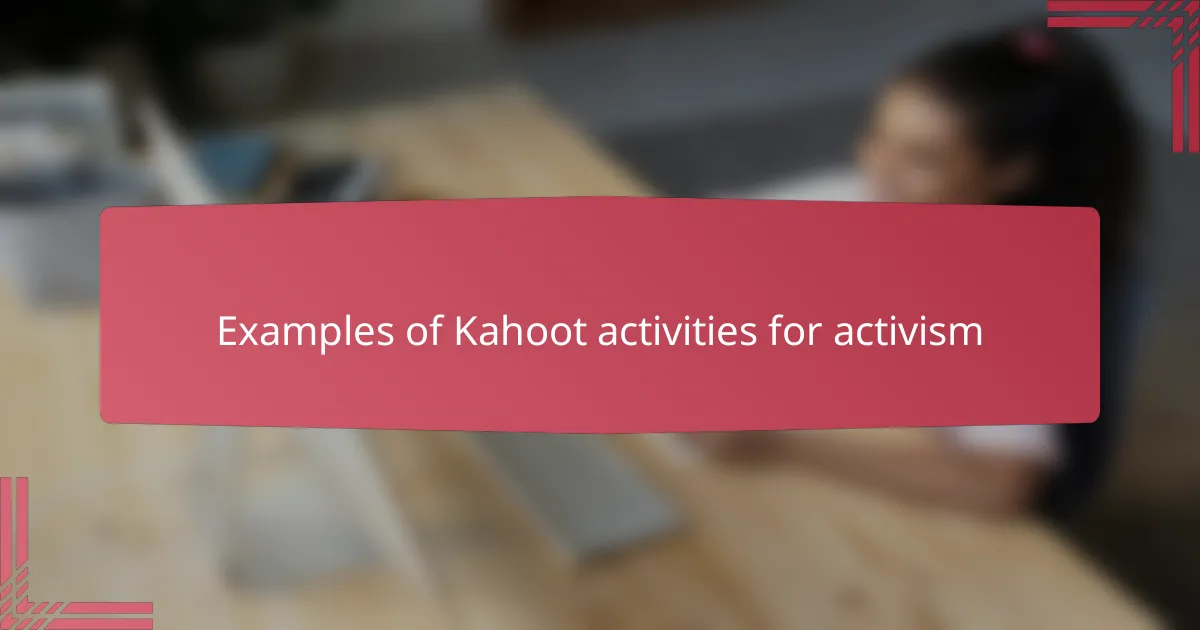
Examples of Kahoot activities for activism
One Kahoot activity I’ve found powerful is creating quizzes that challenge students to identify key figures and moments in social justice movements. It’s incredible to watch them connect names and dates to real stories, sparking their curiosity beyond the screen. Have you ever noticed how seeing history pop up in a game format makes it feel more alive and urgent?
Another approach I’ve used involves polling students on their opinions about current activist issues, like climate change or racial equity. The instant sharing of diverse views often leads to passionate classroom debates afterward. I wonder, doesn’t this kind of immediate feedback deepen their engagement by valuing every perspective?
Finally, I’ve experimented with scenario-based Kahoot questions where students must decide how they’d respond to ethical dilemmas in activism. It’s amazing how this pushes them to think critically and empathize with others. Have you ever tried turning a quiz into a moment of real reflection? For me, those moments are some of the most meaningful in teaching.
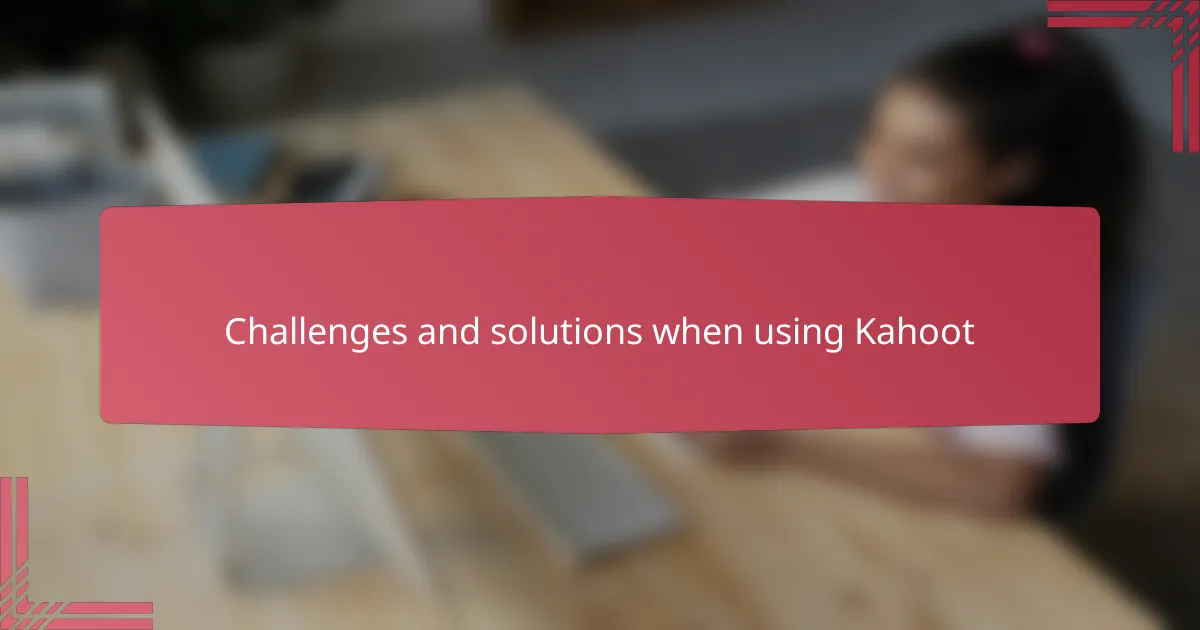
Challenges and solutions when using Kahoot
One challenge I’ve encountered with Kahoot is the occasional technical glitch—slow internet or device issues can interrupt the flow and frustrate students. When this happens, I remind myself to have a backup plan, like a quick group discussion, so the learning momentum doesn’t stall. Have you ever felt that scramble to keep the class engaged despite tech hiccups? It’s an unavoidable part of mixing tech with teaching, and being ready makes all the difference.
Another struggle is maintaining depth in discussions when Kahoot’s fast pace encourages quick answers. I’ve had to consciously slow down, pausing after questions to invite richer conversations and ensure students aren’t just racing for points. How often do we sacrifice reflection for speed? In my experience, balancing engagement with thoughtful dialogue is key to meaningful learning.
Sometimes, students get overly competitive, which can overshadow collaboration and the activist mindset we aim to build. To address this, I emphasize respect and the value of diverse opinions before starting a game, turning competition into a shared journey. Have you noticed how setting that tone early changes the classroom atmosphere? I’ve found it creates a space where every response contributes to our collective understanding.
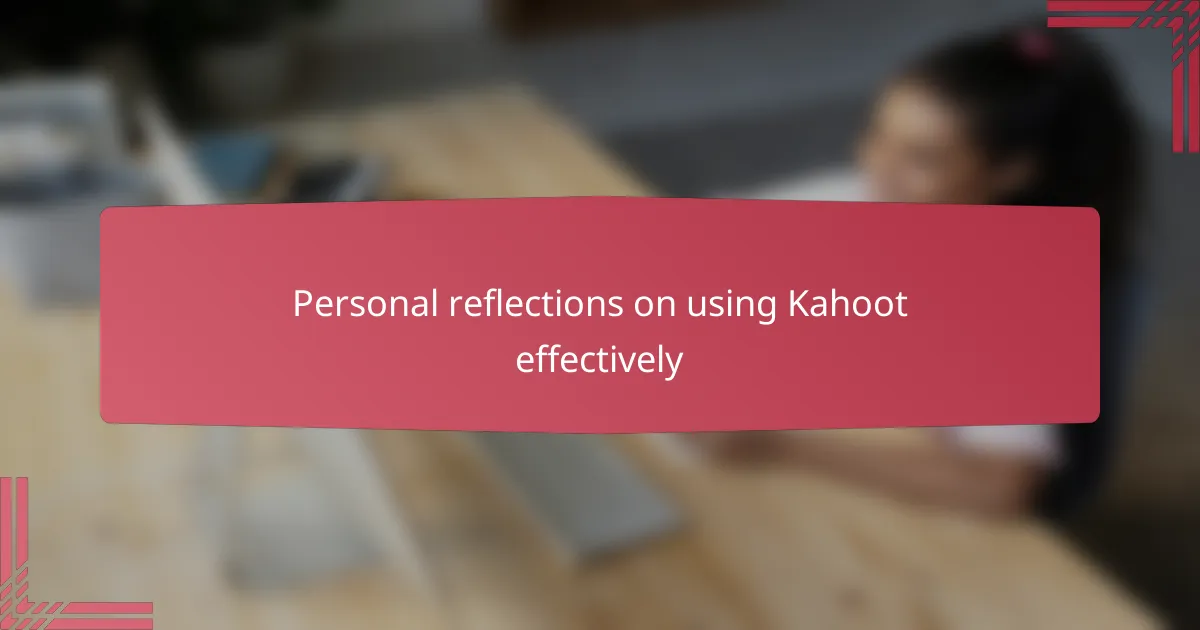
Personal reflections on using Kahoot effectively
Using Kahoot effectively has taught me that timing really matters. I’ve seen lessons transform when I pause right after a quiz question, not rushing into the next activity but inviting students to unpack their answers. It’s in those moments that real thinking and discussion happen, turning a simple game into a powerful learning experience. Have you ever caught yourself wanting to speed through, only to realize slowing down makes the difference?
One thing I’ve learned is the importance of framing Kahoot as more than just a competition. Early on, I noticed some students getting caught up in the points chase, losing sight of the bigger picture. By setting clear expectations that respect and reflection come first, I found the classroom vibe shifted—students started viewing Kahoot as a shared space to explore ideas, not just to win. Doesn’t fostering that kind of mindset change how we connect with our students?
Finally, I can’t overstate how flexible Kahoot’s features are when you’re intentional. From mixing question types to carefully crafting prompts tied to activism, I’ve been able to tailor activities that resonate deeply. It’s rewarding to watch students actively engage not just with facts, but with values and perspectives that matter. Have you experimented with customizing Kahoot to amplify those critical conversations? For me, that personal touch is where the magic happens.